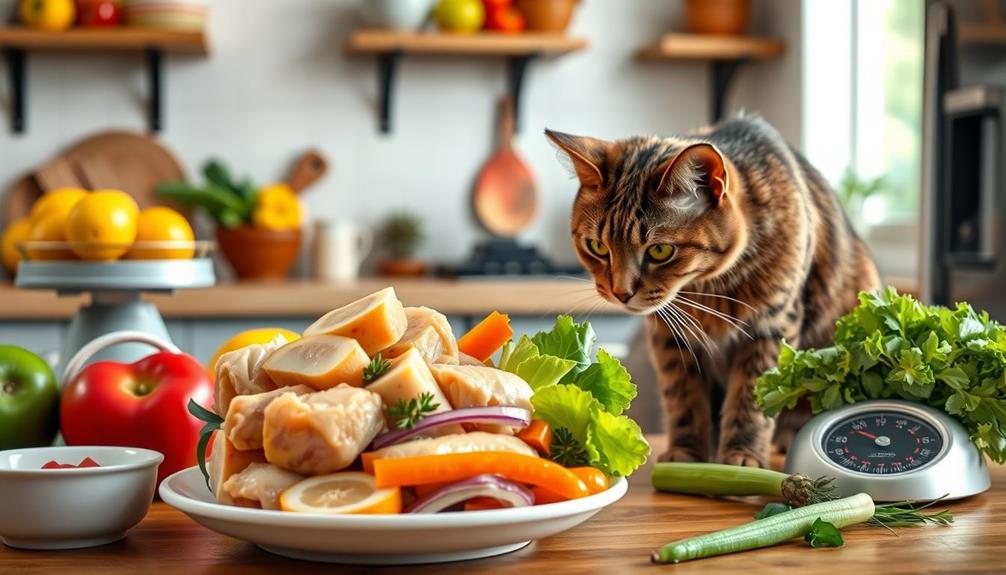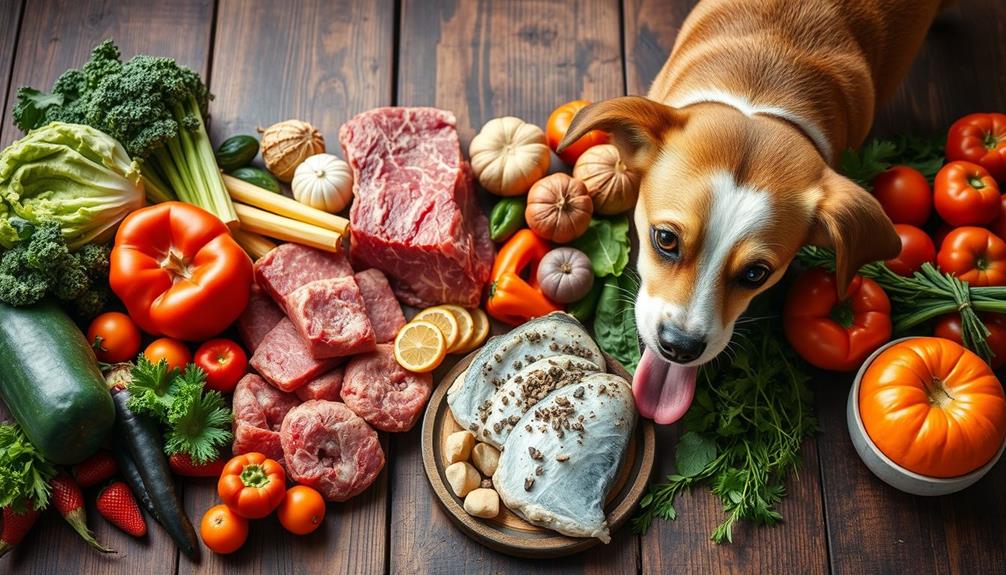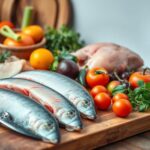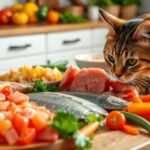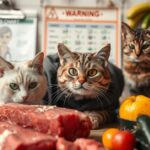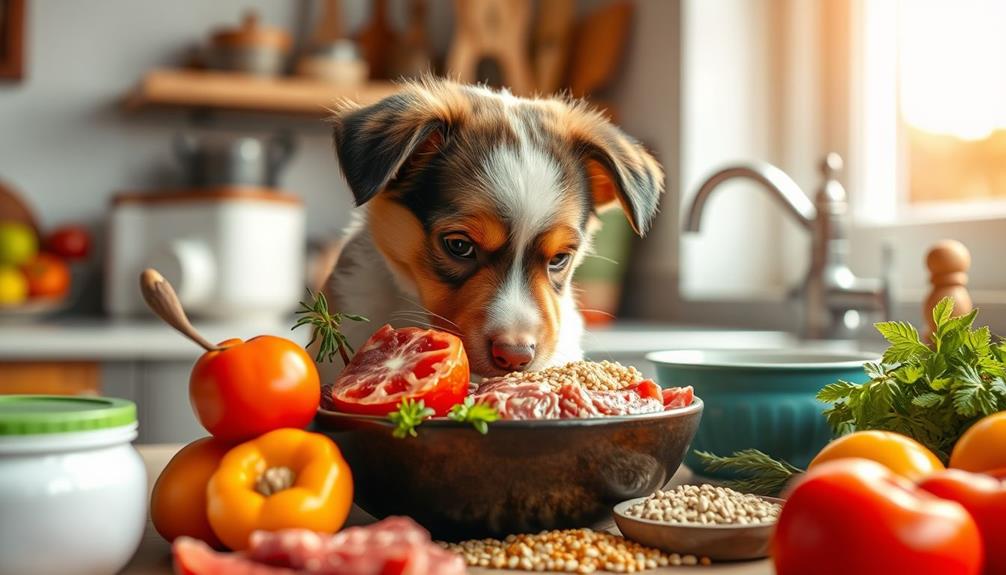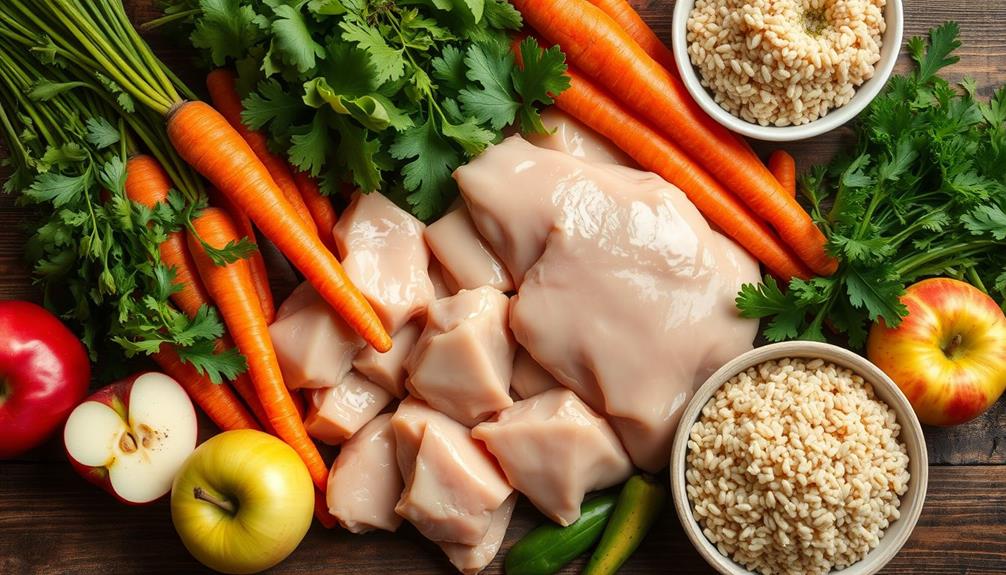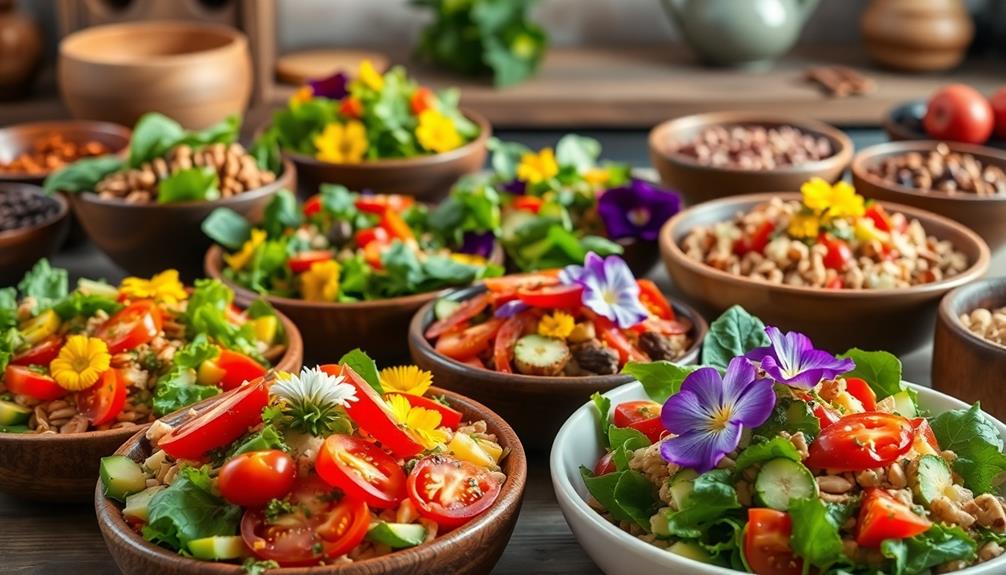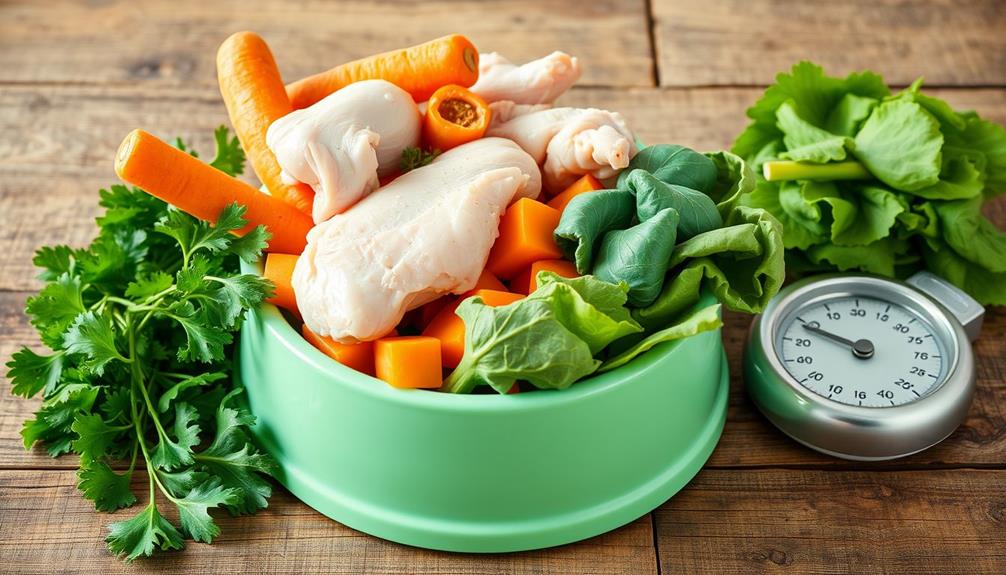Raw food diets for cats can be beneficial, offering high protein and essential nutrients like taurine and vitamins. However, they also carry significant health risks, such as bacterial contamination and potential nutritional imbalances. You'll need to guarantee that any raw diet is well-balanced or consult a veterinary nutritionist to avoid deficiencies. While homemade raw diets allow for ingredient control, commercially prepared options often come fortified with vitamins, making them more convenient. It's essential to maintain strict hygiene practices when handling raw food. If you're curious about how to safely implement a raw diet for your cat, there's much more to explore. Considering the potential risks and benefits of raw food for cats, it’s important to carefully research and consider all factors before making a decision. It’s also crucial to consult with a veterinarian to ensure that a raw food diet is suitable for your specific cat and to address any concerns or questions you may have. By taking the time to educate yourself and seek professional guidance, you can make an informed decision regarding raw food for cats that prioritizes their health and well-being while also taking advantage of the potential benefits.
Key Takeaways
- Raw food diets offer high protein and essential nutrients like taurine, but require careful balancing to avoid deficiencies.
- Homemade raw diets risk nutritional imbalances, while commercially prepared options often ensure balanced nutrition and safety.
- Pathogen contamination is a significant concern with raw diets, with studies showing 25% of samples testing positive for harmful bacteria.
- Major veterinary associations advise against raw feeding, highlighting health risks and the importance of proper food handling.
- Canned cat food can provide similar nutritional benefits with added hydration and lower contamination risks compared to raw food.
Understanding Raw Cat Food
When considering your cat's diet, understanding raw cat food is fundamental. Raw cat food primarily consists of unprocessed ingredients like uncooked meat, fish, internal organs, and ground bone, which are pivotal for meeting the nutritional needs of obligate carnivores.
These diets must provide specific nutrients, including taurine, arachidonic acid, and essential vitamins A, D, and B, to support your cat's overall health. Additionally, it's significant to mention that raw diets, like juice diets for humans, may require careful consideration to avoid nutrient deficiencies and health issues increased risks of contamination.
You can choose between homemade diets and commercially prepared options. Homemade diets require careful balancing of nutrients to avoid deficiencies or excesses, so it's critical to consult with a veterinary nutritionist to create a balanced diet tailored for your cat.
Commercially prepared raw foods are often sold frozen or freeze-dried, offering a more convenient option while still meeting your cat's nutritional needs.
However, feeding raw diets comes with increased risks, such as contamination with pathogenic bacteria like Salmonella and E. coli. To mitigate these risks, strict hygiene practices during preparation and handling are fundamental.
Types of Raw Diets
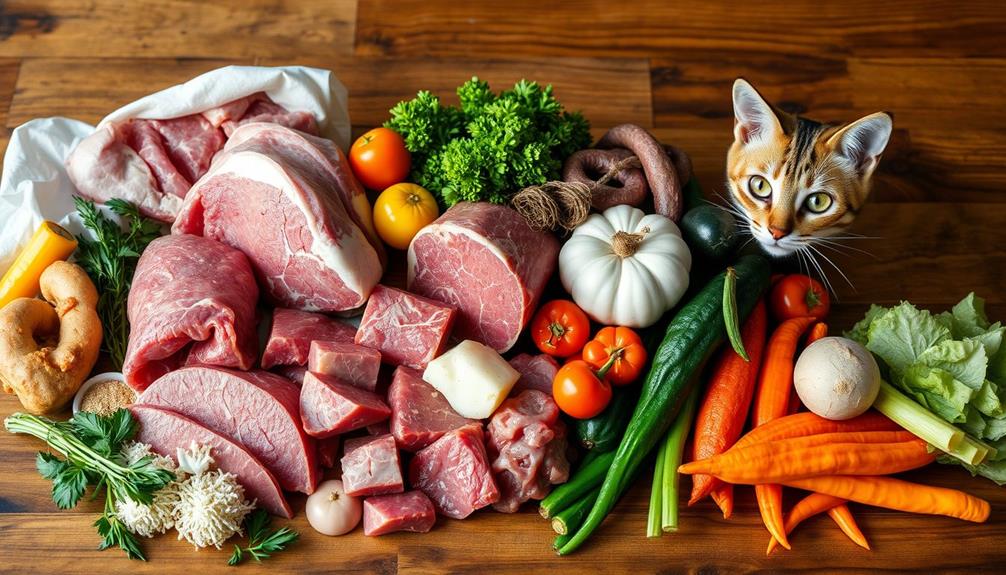
Understanding the different types of raw diets is key to choosing the right one for your cat. You'll find that raw diets generally fall into two main categories: homemade options and commercially prepared raw foods.
| Type | Ingredients | Nutritional Considerations |
|---|---|---|
| Homemade Options | Uncooked meat, organs, ground bone | Requires careful nutrient balancing |
| Commercially Prepared Foods | Frozen or freeze-dried formulas | Often includes added vitamins and minerals for nutritional adequacy |
| HPP Diets | High pressure pasteurized raw food | Kills harmful bacteria without altering nutritional content |
Homemade options allow you to control ingredients, but they require balancing to meet your cat's high protein requirements as obligate carnivores. On the other hand, commercially prepared raw foods offer convenience. Freeze-dried diets retain nutritional quality while minimizing moisture, which is great for storage. HPP diets effectively address safety concerns by eliminating harmful bacteria, ensuring your cat gets the raw cat food it needs without compromising safety. Each type has its benefits, so weigh your options based on your cat's needs.
Safety and Hygiene Practices
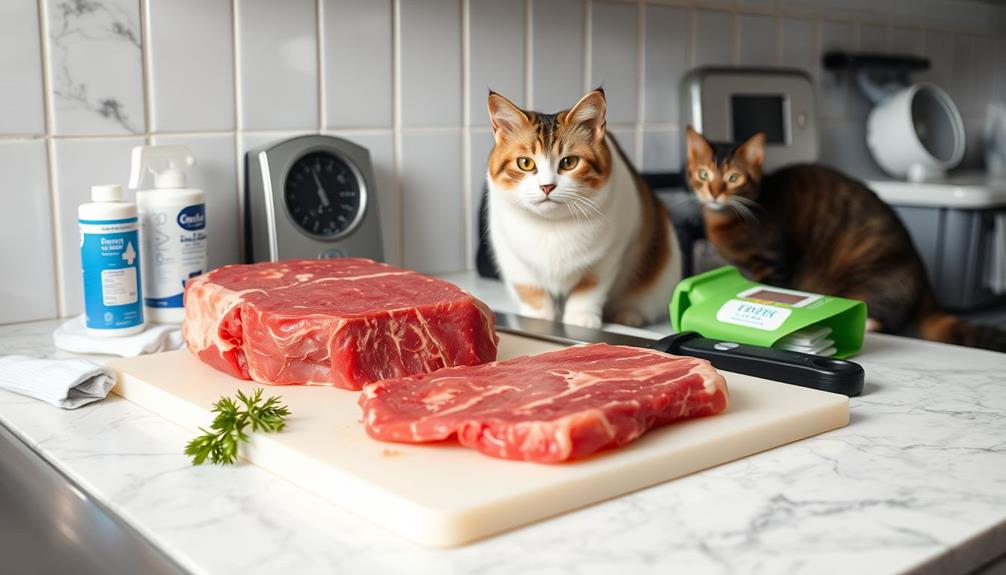
When you choose to feed your cat a raw diet, it's vital to be aware of pathogen contamination risks, like Salmonella and E. coli.
Making sure you follow safe handling guidelines is essential to protect both you and your pet from harmful bacteria, as improper hygiene can lead to serious health issues.
By practicing proper hygiene and food storage, you can minimize these risks and guarantee a safer feeding experience.
Additionally, understanding the importance of cold medications overview can provide insights on how to keep your cat healthy during colder seasons.
Pathogen Contamination Risks
Raw cat food poses significant pathogen contamination risks, making safety and hygiene practices vital for pet owners.
Studies show that nearly 25% of raw pet food samples test positive for harmful bacteria like Salmonella and E. coli. The USDA estimates that 25% of raw chicken is contaminated, which raises concerns about feeding raw diets to your cat.
To guarantee your pet's health and maintain a proper budget for their diet, it's important to weigh the costs and benefits of raw feeding.
To protect both your cat and yourself from zoonotic diseases, consider following these safe handling practices:
- Always wash your hands thoroughly after handling raw cat food.
- Keep raw cat food separate from human food to avoid cross-contamination.
- Disinfecting surfaces that come into contact with raw food is vital to minimize bacterial contamination.
- Avoid direct contact with your cat's face after they've eaten raw food.
Safe Handling Guidelines
To guarantee your cat's safety while feeding a raw diet, following strict handling guidelines is vital. First, always thoroughly wash hands with soap and water immediately after handling raw cat food to prevent the spread of harmful bacteria, particularly if the food is contaminated with Salmonella.
Additionally, make sure that the area where you prepare your cat's food is well-ventilated to reduce the concentration of any airborne pathogens, similar to maintaining good airflow around a purification unit. Next, clean and disinfect all surfaces, utensils, and equipment that come into contact with raw food to minimize cross-contamination.
When storing raw cat food, make sure to keep it at safe temperatures. Store it frozen until you're ready to use it, and thaw it in the refrigerator or microwave to prevent bacteria from multiplying.
It's also essential to avoid rinsing raw meat before preparation, as this can splash bacteria onto surrounding surfaces and increase contamination risk.
Additionally, keep raw food separate from human food to prevent any cross-contact. After your cat has eaten, avoid direct contact between their mouths and your hands to further reduce exposure to pathogens.
Nutritional Value Comparison
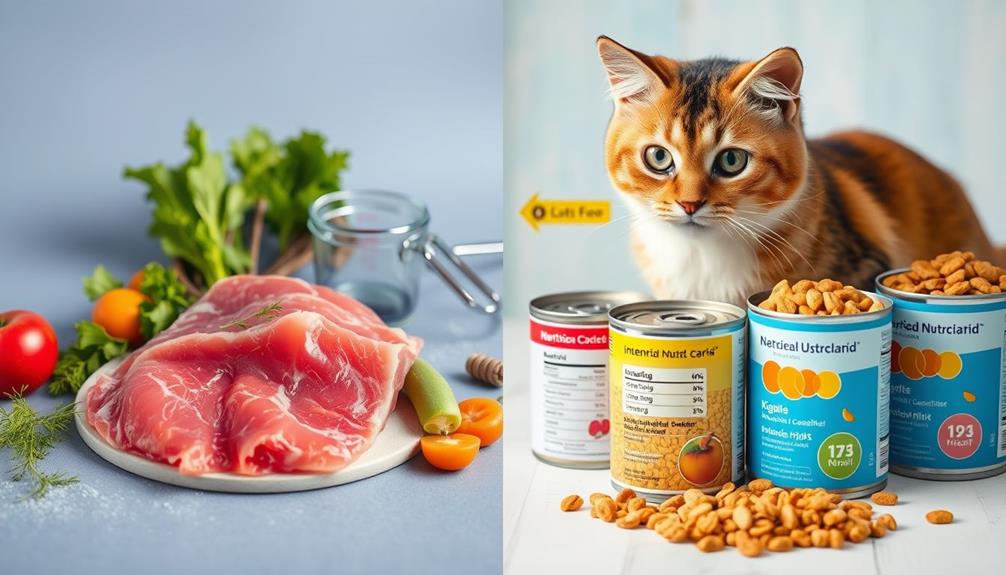
Nutritional integrity plays an essential role in deciding the best diet for your cat. While high-quality raw cat foods may boast higher antioxidant levels, they don't always provide superior nutrition overall.
Cats require a balanced intake of specific nutrients, including taurine, arachidonic acid, and essential vitamins like A, D, and B. Failing to balance these in raw diets can lead to deficiencies and health issues.
It's also important to reflect on the potential emotional and psychological impact on your pet's well-being, as support resources available for caregivers can highlight the significance of a well-rounded diet.
Ponder these points when evaluating nutritional value:
- Contamination Risk: Nearly 25% of raw pet food samples tested positive for harmful bacteria, raising safety concerns.
- Homemade Dangers: Homemade raw diets often lack scientific formulation, which can result in nutritional imbalances.
- Canned Alternatives: High-quality canned cat foods can offer similar nutritional benefits with higher water content and fewer health risks.
- Nutritional Balance: Ensuring your cat receives a balanced diet is essential for their overall well-being.
Ultimately, while raw diets have their proponents, it's important to weigh the potential risks against the nutritional benefits for your furry friend.
Always prioritize safety and nutritional completeness when selecting cat foods.
Health Benefits and Risks
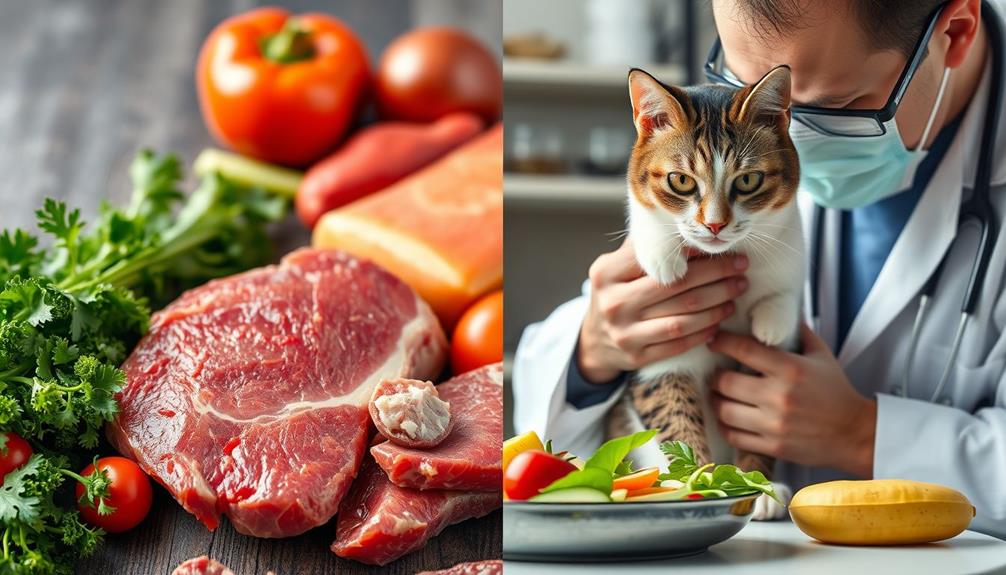
When considering a raw food diet for your cat, you'll notice potential nutritional advantages that align with their natural instincts, similar to the dietary needs of small pets like hamsters which require a balanced diet for ideal health.
However, these benefits come with significant health risks, including the threat of bacterial contamination, as seen in the importance of proper food handling in animal care safe snacks for hamsters.
It's essential to weigh both sides carefully before making a decision.
Nutritional Advantages of Raw
Raw diets for cats can offer significant health benefits, primarily due to their high protein content and essential nutrients tailored to meet the needs of obligate carnivores. When you switch to raw meat-based diets, you might notice improvements in your cat's energy levels and overall body condition. This aligns with their ancestral eating habits, which emphasize a protein-rich diet.
Additionally, incorporating a variety of raw foods can support overall health and wellness by providing a diverse nutrient profile, similar to the concept of maintaining a balanced diet rich in fruits, vegetables, and whole grains.
Consider the following nutritional advantages of raw diets:
- High protein levels: Essential for maintaining muscle mass and overall health.
- Taurine: A critical amino acid that supports heart and eye health.
- Arachidonic acid: Significant for skin and coat health.
- Vitamins A, D, and B: Essential for various bodily functions.
However, it's significant to recognize that homemade raw diets can lead to nutritional imbalances if not carefully formulated. Consulting with a veterinary nutritionist can help you guarantee your cat gets all the essential nutrients they need.
While raw diets have their benefits, high-quality canned foods can also provide a balanced nutrient profile with lower risks of contamination. Always weigh your options to choose the best diet for your feline friend.
Health Risks Involved
Understanding the health risks associated with feeding raw diets to cats is vital for any pet owner. Raw cat food can be contaminated with harmful pathogens, with studies revealing that nearly 25% of raw pet food samples test positive for Salmonella and E. coli. These bacteria can lead to severe infections not just in your cat but also in humans.
The CDC estimates about 1.2 million cases of foodborne salmonellosis occur in the U.S. annually, especially affecting vulnerable populations like children and the elderly. Additionally, it's important to take into account that the nutritional balance of a raw diet may not be ideal, as many pet owners overlook the importance of proper meal planning and ingredient selection mastering the art of bug out bags.
Cats can carry pathogens like Salmonella and Listeria asymptomatically, posing a risk of transmission to humans, particularly in households with immunocompromised individuals. The American Veterinary Medical Association advises against raw feeding due to the lack of scientific support for its nutritional benefits and the heightened health risks involved.
While proper handling practices, such as thorough handwashing and disinfecting surfaces, can help mitigate risks, the safest option is to avoid feeding raw food altogether. Pet food manufacturers generally provide safer alternatives that meet your cat's nutritional needs without the associated health risks.
Veterinary Insights on Raw Feeding
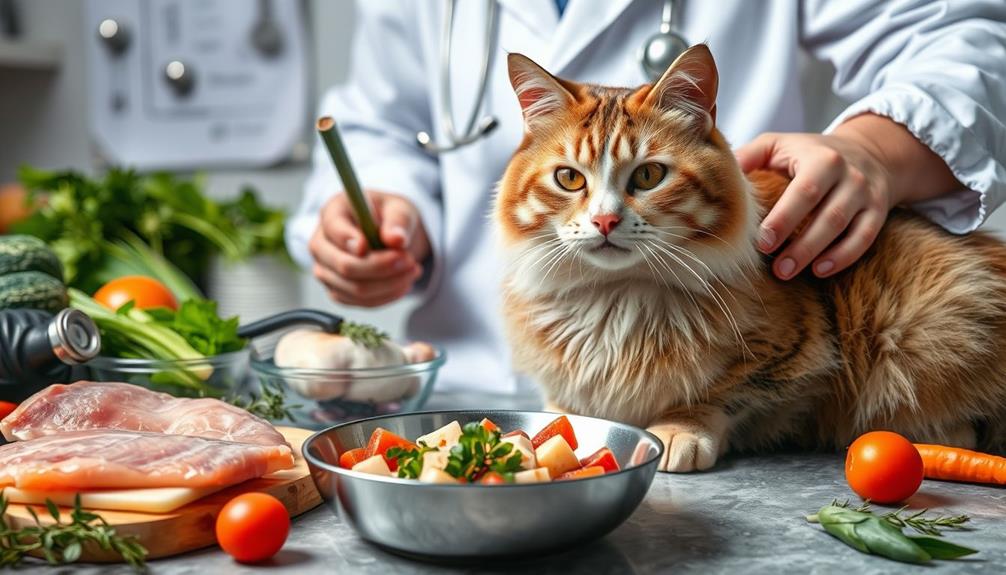
Veterinary insights on raw feeding reveal significant concerns about the practice's safety and nutritional adequacy. Major veterinary associations, including the American Veterinary Medical Association, caution pet owners against raw feeding due to its associated health risks and a lack of scientific support for its benefits.
Research indicates that nearly 25% of raw pet food samples are contaminated with harmful bacteria like Salmonella and E. coli, which poses risks not only to your cat but also to your family.
Additionally, pet owners should be aware of the emotional dysregulation that can arise in animals due to improper diets, leading to increased stress and anxiety in pets, similar to understanding the mirroring dynamic observed in individuals with BPD.
When considering homemade raw diets, veterinarians stress the need for proper formulation to avoid nutritional deficiencies. Many raw diets fail to provide essential vitamins and minerals, leading to serious health complications.
Here are some key insights:
- Raw diets can lead to nutritional deficiencies.
- Zoonotic diseases may be transmitted through improperly handled raw food.
- Consultation with a veterinary nutritionist is essential for balanced homemade diets.
- Education for pet owners about raw feeding's risks is critical.
Frequently Asked Questions
Is Raw Food Really Better for Cats?
Nearly 25% of raw pet food samples test positive for harmful bacteria. So, while you might wonder if raw food's better for cats, consider the potential health risks and nutritional imbalances associated with these diets.
Do Vets Recommend a Raw Diet for Cats?
Vets generally don't recommend a raw diet for cats due to health risks like harmful bacteria and nutritional imbalances. They often suggest high-quality, balanced commercial diets to guarantee your cat's health and well-being.
Do Cats Live Longer on a Raw Diet?
You might think a raw diet makes your cat immortal, but it doesn't. In fact, nutritional deficiencies and health risks from raw food can shorten their lifespan. Balanced diets often support longevity better than raw options.
Do Cats Prefer Raw or Cooked?
When it comes to preferences, many cats tend to favor raw food due to its texture and aroma. However, some might still choose cooked options, so it's best to observe your cat's individual tastes.
Conclusion
In the end, deciding if raw food is best for your cat isn't just about trends; it's about what keeps your furry friend healthy and happy. While raw diets can offer benefits, they also come with risks that you can't ignore. So, ask yourself: is the potential for a healthier cat worth the extra effort? By weighing the pros and cons, you'll find the perfect balance for your beloved companion's diet.

